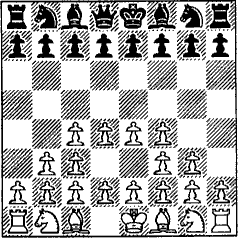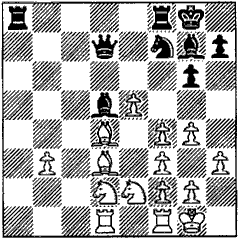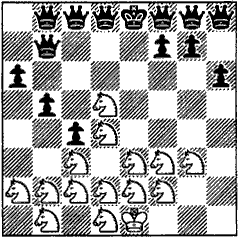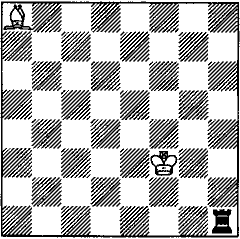Variant Chess Index
|
The magazine to broaden your chess horizons
|
Contents
|
The Chess Variant PagesThe officers of the BCVS have recently been contacted by David Howe, Editor in chief of The Chess Variant Pages, who has offered to reproduce selected articles from each issue of Variant Chess on their website. After discussing the matter we were happy to accept. The two organisations cover the same field, and Variant Chess will be brought to the attention of a much wider potential readership, while The Chess Variant Pages will extend their already formidable coverage of the field. Truly a meeting of minds. The History of the Chess Variant Pages In January 1995 Hans Bodlaender started a small website on chess variants. Later he wrote descriptions of a number of variants that he found most interesting (e.g. those of several historic chess variants). After a while, interest began to grow and people began to send additional materials; the older materials were improved. In the following years the website became better known, was mentioned in several places, and received more and more visitors (and awards). The total of all hits up to the end of November 2000 is more than fifteen million. In the spring of 1997, David Howe offered his help in building the site, and in the spring of 1999 the editorial board was further increased, the site was moved and a domain name was obtained. In the week of 5-11 March 2001 alone, the site was augmented by an introduction to Shogi, information on the historic variant Tamerlane Chess, and ten new variants! Deadline for Contributions to VC38 Please aim to deliver them by the first of June 2001. |
||||||||||||||||||||||||||||||||||||||||||||||||||||||
|
UNBALANCED GAMES by John Beasley There is a class of chess games in which White and Black have different sets of men and perhaps different objectives. The concept is familiar in physical sport, where ball-and-stick games such as cricket and baseball are widely played, but in these games the players take each role in turn and the object is to score more points than the opponent. The simple "win or lose" result of chess is not amenable to such treatment, and unbalanced chess games can easily become "who wins?" puzzles rather than vehicles for competitive play. Even so, they have their interest, and they are particularly suitable as subjects for "own invention" play and analysis: something to keep the mind busy when no opponent is to hand for a conventional game. The simplest are the one-against-many games in which a single man with superior powers is pitted against a large army of standard men. Such games are very old. A quick browse through Murrays "History" brought to light the game "De cercar la liebre" from the "Alfonso" manuscript of 1283 (Murray, A History of Chess, pp 568-9, 616-7) in which ten to twelve men have to catch a hare on a 5x5 board, and I am sure those knowledgeable in board game history will be able to tell me of still earlier examples. The same passage of Murray mentions the game of Fox and Geese which I remember from my childhood (White has four geese which move one square diagonally forward, Black one fox which moves one square diagonally in any direction, no capturing, the fox aims to reach Whites first rank and the geese aim to hem him in). I eventually worked out that the geese could always win, though not if they were careless, and this seems to be typical of such games: either the single man has a quick win or the many have a slow, and the analysis is not greatly difficult. For example, Murray (p 347) mentions a work by Lala Raja Babu which describes various games
|
including a "Shatranj diwana shah" where a solitary king able to move as any piece is pitted against a complete army. This game has attracted some attention in the modern literature, and The Encyclopedia of Chess Variants (pp 183-4) shows a win for the army. The rules can easily be varied in detail, and the Chess Variants pages (www.chessvariants.com) describe a version "Tiger hunt" in which the complete army lacks its queen. I think the army still wins (king, knights, and bishops appear sufficient to support the pawn barrier, leaving the rooks free to stake out new ground), but have not proved it in detail. Slightly more sophisticated are few-against-many games, where the single man has companions. Murray mentions another game from Lala Raja Babu in which two lions on d1/e1 face 32 goats on ranks 5 to 8, but I cannot find the detailed rules. Better known is Monster Chess, where the initial array is
and Black is allowed to make two moves at once. But this also is a win for the larger army (for a crib, see the Chess Variants pages, item "Muenster Chess"), and the reason lies in the fact that the smaller army still cannot afford to allow a man to be captured; even two-for-one swaps are likely to be good for the larger army. Much more scope is offered by multiple pawn games, where one side lacks a queen or some other man but has a number of extra pawns to compensate. Unlike most chess variants, these have been played at master level. They were played by Labourdonnais and Deschappelles at the Régence (Encyclopedia, p 223), and Alexandres Collection des plus beaux problèmes déchecs of 1846 gives four games by Kieseritsky. One
|
of these is in the Encyclopedia; here is another.
White Kieseritsky, Black Desloges. 1.d4-d5 d7-d6 2.e4-e5 (White wants to throttle Black rather than to give him open lines, and my instincts would be to play 2.f5 aiming for a stonewall formation) 2...e7-e6 3.e2-e4 c7-c6 4.d5xe6 f7xe6 5.d2-d4 Nb8-a6 6.Bf1-d3 b7-b6 7.Bc1-e3 Bc8-b7 8.Ng1-e2 g7-g6 9.Nb1-d2 Ng8-h6 10.h2-h3 Bf8-g7 11.0-0 0-0 12.a2-a3 d6-d5 13.c4xd5 c6xd5 14.c3-c4 Ra8-c8 (in the light of what follows, ...Qd7 and ...Rfc8 might have been better) 15.c2-c3 Na6-c7:
16.Ra1-d1 (a truly mysterious rook move, but "D1B1" appears later so it cannot be a misprint) 16...a7-a6 (Black is playing to open lines on the queens side) 17.a3-a4 Qd8-d7 18.g3-g4 b6-b5! 19.a4xb5? (this gives Black an open file at once and must surely be wrong) 19...a6xb5 20.c4xb5 Nc7xb5 21.c3-c4? (and this is worse, loosening Whites position and opening lines which Black will be able to exploit better than White) 21...d5xc4 (the source has "D7C4", which had me blinking for a minute) 22.b3xc4 Nb5-c7 23.b2-b3 Rc8-a8 (I would have been tempted by 22...Na6 aiming for b4, but it might have been difficult to maintain a man there) 24.d4-d5 Nh6-f7 25.Be3-d4 (25.d6
|
|
UNBALANCED GAMES
would avoid what is to come) e6xd5 26.c4xd5 Nc7xd5 (Black thinks this sacrifice is worth while, and I agree) 27.e4xd5 Bb7xd5:
I reckon Black should now win. He still has queen for knight, he can rampage at will on the queens side, and Whites pawns are not far enough advanced to be a serious threat. But he frittered away his advantage, and it was not to be. Play continued 28.Nd2-c4 Qd7-b7 29.Nc4-d2 Rf8-b8 30.Rd1-b1 Ra8-a2 (this attack is ephemeral, and Black should probably bring bNf7 and bBg7 into better play before indulging in tactics) 31.Nd2-e4 Ra2xe2? (and his material superiority is certainly not so great that he can afford moves like this) 32.Bd3xe2 Bd5xe4 33.f3xe4 Qb7xe4 34.Bd4-e3 g6-g5 (an understandable attempt to undermine wPe5, but I think it hurts Black more than White) 35.g2-g3 (better was 36.Bf3 with e6 and f5 to follow) 35...g5xf4 36.g3xf4 Nf7-d8 37.Be2-c4+ Kg8-h8 38.Rf1-d1 Bg7-h6 39.Rb1-c1 Qe4-f3 (whyever not the natural 39...Bxf4?) 40.Be3-d4 (in those days gentlemen would only attack, but the consolidating 40.Bf1 seems better) Qf3xh3 41.Rd1-d3 Qh3-h4 (41...Qxg4+ loses to 42.Rg3, because of the mate threat on g8) 42.e5-e6+ Bh6-g7 43.Bd4xg7+ Kh8xg7 44.Rd3-d7+ and Black played 44...Kg7-f8 allowing 45.e6-e7+. Had he not thrown away a good attacking piece by the overconfident 31...Rxe2, the result might have been very different. According to Hans Bodlaender and Ralph Betza, writing in the Chess Variants pages, Labourdonnais and Deschappelles found eight pawns for the queen to be too much, and "probably they played with five or six or seven extra Pawns". There still
|
seems scope for experiment here, and I doubt if the history of these games is finished. According to the Encyclopedia, multiple pawn games date from the 18th century. Wholly modern are anti-computer odds games. These exploit a blind spot inherent in most computer chess programs, that if the machine thinks it has a win on material but cannot see how to win more material or force mate within its calculation horizon, it simply optimizes its position in some sense and then plays neutral moves to preserve its advantage. There is a hilarious description from the early days of computer chess in Bill Hartstons How to Cheat at Chess. Anti-computer games are even more ephemeral than most, because odds which give a good game against one computer may be hopelessly impractical against the next, but they can be good fun while they last. For example, in the 1980s I used to play against White Knight II on my BBC Model B at odds of queen. Impossible, you may say, since White Knight II was competently written and could win won endings. But I used the standard anti-computer strategy, blocking the centre and giving it nothing to bite on, and once it had completed its development it would see no way of improving its position and would start noodling. Meanwhile, I would gradually build up a kings-side attack, ending in a breakthrough sacrifice, and even with no queen to sharpen the attack I was able to score something like 40%. More radically, I sometimes play against Genius 2 on my 486/25 with the following array:
Genius is willing to accept this as a starting position, and on material it
|
should be an easy win for the queens. In practice... 1.Nh1-g3 e7-e5 (the machine was set to five seconds a move) 2.Na1-b3 d7-d5 3.Na2-c3 c7-c5 4.Nh2-f3 (a blunder, but I hadnt played for a while) 4...c5-c4 5.Nb3-d4 (White normally loses a knight for two pawns early on, and while a knight for one pawn is bad he will get a second because d5 cannot be defended) 5...e5xd4 6.Nf3xd4 a7-a6 7.Ng1-f3 b7-b5 8.Nc1-a2 (not pleasant, but I didnt think I could stand ...b4 winning a second knight) 8...Qd8-f6 9.Nf1-e3 Qa8-b7 10.Ng2-f4 h7-h6 11.Nf4xd5 Qf6-d8:
This is a typical position coming out of the opening. Now the White army will gradually flow forwards (the pawn on c4 is awkward but not insuperable), and Black has got to sacrifice some material to simplify things. He can afford to give away any number of queens for two knights each, but the computer doesnt think like this, and usually it refuses to part with any material at all until Whites increasing command of the board forces it to do so. I eventually won from this position, but only by making no oversight (for once); the slightest mistake, and the queens pounce. Absurd though they may seem, games of this kind have two great practical advantages: (a) the chances can be made more or less even by adjusting the relative rates of play, and (b) whereas a human player, once he has found a guaranteed winning strategy, will spoil the game by using it all the time, a computer has a "randomizer" and does something different every time you play. Try them out for yourselves. A serious contribution to chess development they are not, but they will give more than a little passing pleasure. |
|
PROBLEM PAGES by Ronald Turnbull 340 - RT
Mate in 2, Avalanch (Note: this problem in its original form was flawed. The diagram was changed on 6 June 2001 to correct this flaw. The white Bishop was moved from b5 to a4, and a black pawn was added on a5. --D. Howe) |
Solution: You'll have to wait for the next issue of VC (issue 38)! |
|
THE END IS NIGH by Paul Byway #94 Paul Byway
Losing Chess |
Solution: * |








